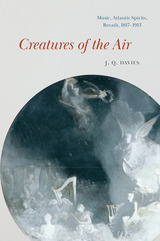
The work in Creatures is centered on the imaginative and playful idea of the Dabloids, foot-shaped creatures of all sizes and colors who emerge magically from the Dablus, a sausage-like object that appears one misty morning in the fields of a collective farm. Tishkov’s drawings, paintings, and sculptures recount the history of the Dablus and the Dabloids. These mystical creatures are at once pets and gods, beings immensely wise and yet foolish. They are surreal manifestations of the artistic consciousness even as they are symbols of human isolation. In this sense, Tishkov’s roots in surrealism are charged with humorous social commentary often reminiscent of Hogarth, Red Grooms, and Robert Crumb.
Tishkov explores other mythological and absurdist themes in a series of elephant watercolors in which people live within an elephant trunk. The book also features a translation of the text of Tishkov’s play "Dabloids—A Fantasy," as well as brief essays that provide an introduction to the artist and his work, his mythology, and his roots in Russian folk culture.
Creatures introduces a major contemporary Russian artist to the western world. It should delight all who enter its world and should expand the horizons of all who delight in its artistic merits.

From flying squirrels on high wooded plateaus to hanging gardens in redrock canyons, the Intermountain West is home to some of the world's rarest and most fascinating animals and plants. Creatures of Habitat details many unique but little-known talents of this region's strange and wonderful wild inhabitants and descibes their connections with native environments. For example, readers will learn about the pronghorn antelope's supercharged cardiovascular system, a brine shrimp-powered shorebird that each year flies nonstop from the Great Salt Lake to Central Argentina, and a rare mustard plant recently discovered on Mount Ogden. Emphasizing how increasing loss and degradation of habitat hinders native species' survival, Mark Gerard Hengesbaugh discusses what is happening to wildlife and wild places and what is being done about it.
Well illustrated, this book has habitat maps, pen-and-ink illustrations, and fifty photos of wildlife and wild places selected by photo editor Dan Miller. Also included are guides to wildlife viewing and lists of Utah species, including those considered sensitive, threatened, or endangered.


Often experienced as universal and incorporeal, music seems an innocent art form. The air, the very medium by which music constitutes itself, shares with music a claim to invisibility. In Creatures of the Air, J. Q. Davies interrogates these claims, tracing the history of music’s elemental media system in nineteenth-century Atlantic worlds. He posits that air is a poetic domain, and music is an art of that domain.
From West Central African ngombi harps to the European J. S. Bach revival, music expressed elemental truths in the nineteenth century. Creatures of the Air tells these truths through stories about suffocation and breathing, architecture and environmental design, climate strife, and racial turmoil. Contributing to elemental media studies, the energy humanities, and colonial histories, Davies shows how music, no longer just an innocent luxury, is implicated in the struggle for control over air as a precious natural resource. What emerges is a complex political ecology of the global nineteenth century and beyond.
READERS
Browse our collection.
PUBLISHERS
See BiblioVault's publisher services.
STUDENT SERVICES
Files for college accessibility offices.
UChicago Accessibility Resources
home | accessibility | search | about | contact us
BiblioVault ® 2001 - 2024
The University of Chicago Press









